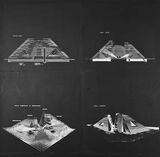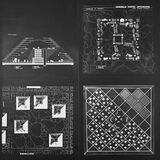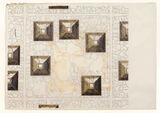Vjenceslav Richter
Vjenceslav Richter (1917, Drenova, Croatia - 2003, Zagreb, Croatia) earned his degree in architecture at the Technical Faculty in Zagreb in 1949. He is one of the founders of Exat 51 (1951), Studio of Industrial Design (1956) and the Centre for Industrial Design (1963) in Zagreb. Richter headed the Architecture Department at the Academy of Applied Arts in Zagreb (1950-1954). In all his activities, from designing the exhibition spaces Pavilion for the World Exhibition in Brussels 1958 and Triennale of Milan in 1964, to painting, Richter carried out the principle of artistic synthesis. Beginning in the early 1960s he developed a systematic approach to urban planning (sinturbanizam) and sculpture (system sculpture), from the 1970s in print works, and from the 1980s in system painting. Richter also created acknowledged stage set designs for major opera and theater performances.
Selected works[edit]
- Synthurbanism, 1963-1964
All images courtesy of Vjenceslav Richter Archive, Museum of Contemporary Art, Zagreb.
Catalogues[edit]
- Juraj Dobrović, Eugen Feller, Mladen Galić, Ante Kuduz, Ivan Picelj, Aleksandar Srnec, Miroslav Šutej, Belgrade: Muzej savremene umetnosti, 1968, [10] pp. With text by Ješa Denegri. (Serbo-Croatian)
- Vjenceslav Richter, Zagreb: Galerija suvremene umjetnosti, 1968. (Croatian)
- Vjenceslav Richter, Belgrade: Muzej savremene umetnosti, 1969. (Serbo-Croatian)
- Vjenceslav Richter. Plastiken, Systeme, Architektur, intro. Vera Horvat-Pintarić, eds. Gottfried Biedermann and Ulrike Kortschak, Graz: Neue Galerie am Landesmuseum Joanneum, 1972, [88] pp. (German)
- Vjenceslav Richter. Systemic Graphics, Zagreb, 1973, 36 pp. (English)
- Juraj Dobrović, Julije Knifer, Vjenceslav Richter. Yugoslavia. XII Bienial de Sao Paulo, ed. Božo Bek, Interrepublic Coordinative Commitee for Cultural Relations with Foreign Countries of R.S.F. Yugoslavia, 1973, [39] pp. (English)
- more
Publications[edit]
- Sinturbanizam, Zagreb: Mladost, 1964, 103 pp. [1] (Serbo-Croatian)
- "Subjektivne projekcije svijeta", Zivot umjetnosti 15-16, Zagreb, 1971. (Serbo-Croatian)
- A Challenge to the Heritage: A General Method of Dividing Angles and a New Division of the Circle, Zagreb: Ceres, 1996, 47 pp. (English)
- Herausforderung an das Erbe allgemeine Methode der Winkelteilung und neue Kreisteilung, trans. Rada Govedarica and Zrinka Kuzmanić, Zagreb: Ceres, 1997, 48 pp. (German)
- The Philosophy of the Improbable, 1997.
Literature[edit]
- Vera Horvat-Pintarić, Vjenceslav Richter, Zagreb: Grafički zavod Hrvatske, 1970, 108 pp. [2] (Croatian)/(English)
- Vladimir Kulić, "Vjenceslav Richter’s Sinturbanizam", Institute of the Present, Feb 2020. (English)
- "Proiectul Sinturbanizam al lui Vjenceslav Richter", Institute of the Present, Feb 2020. (Romanian)






